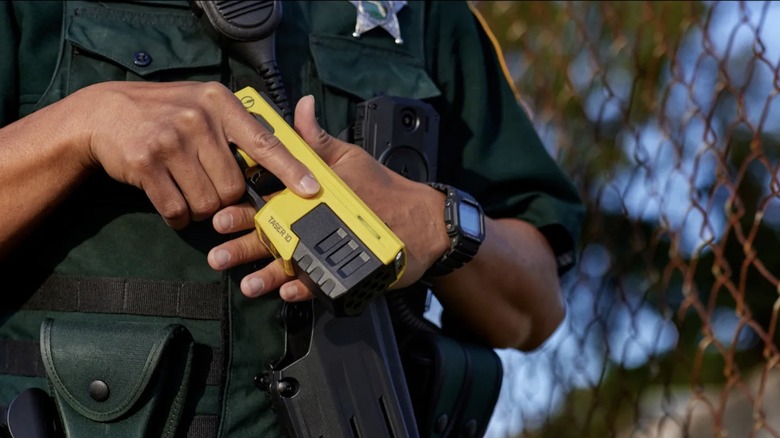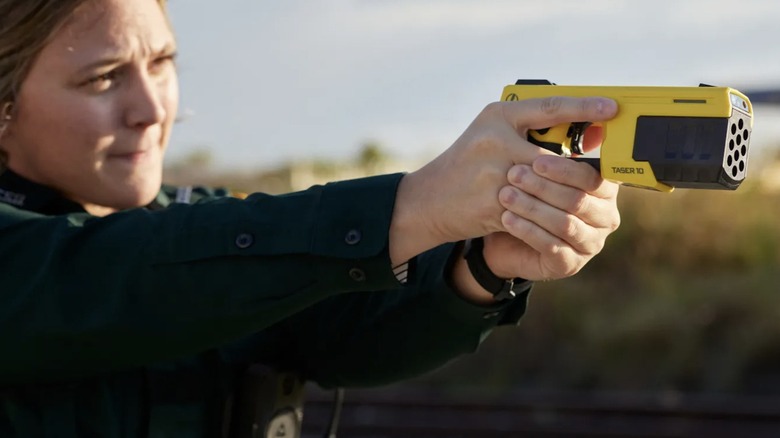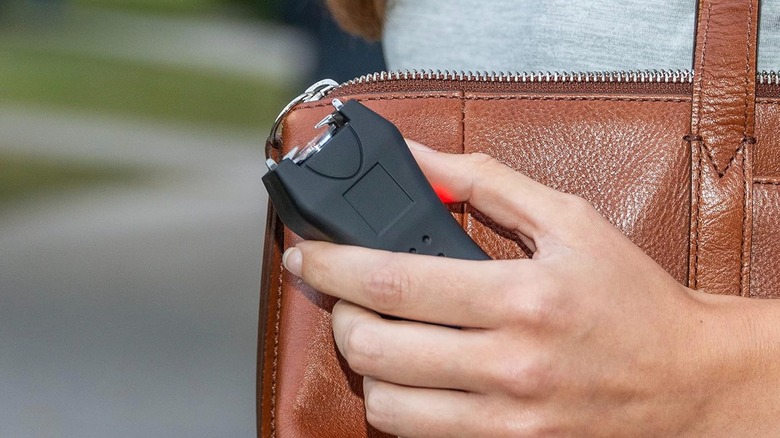What Does TASER Stand For & In Which US State Is It Illegal To Carry One?
We may receive a commission on purchases made from links.
"Taser" and "laser" are both types of energy weapons, while also both acronyms, so it wouldn't be ridiculous for you to assume that most of the letters in each mean the same thing. However, this isn't the case, and in fact they have very different meanings. Laser was first coined in 1959 and is short for "Light Amplification by Stimulated Emission of Radiation," whereas Taser stands for "Thomas A. Swift Electric Rifle." Taser is actually likely to be a backronym — a word conceived first (likely inspired by the word laser, which was already in the common vernacular when the taser was invented in the 1970s) and then the phrase "Thomas A. Swift Electric Rifle" was retrofitted to match the letters.
Thomas A. Swift is not the inventor of the taser — he's not even a real person. The inventor is Jack Cover, who used the 1911 story "Tom Swift and His Electric Rifle" as the inspiration for the name. In fact, Thomas A. Swift isn't even the correct name for the original character — the "A" was added by Cover simply to make the acronym work.
While the taser invented by Cover isn't exactly an electric rifle, the name does suit the device — it works by firing two dart-like electrodes that remain connected to the device by wires. Once attached to the target, the electrodes deliver an electric current strong enough to disrupt voluntary muscle control, incapacitating them. This is very different from how weaponized lasers are used, such as the U.S. Navy's HELIOS system. Tasers have become an increasingly popular choice by law enforcement officials looking for less-lethal ways to subdue suspects. Tasers can even be owned and used by civilians — but not everywhere.
All but one state allow you to own a taser, but it's not a free-for-all
Tasers are legal to own nearly everywhere in the United States, with the exception of just one state — which happens to be, geographically, the smallest: Rhode Island. There had been some other holdouts where tasers were also illegal, including New York, New Jersey, Massachusetts, and Hawaii, but eventually these states allowed the device within their borders.
However, that doesn't mean everyone outside of Rhode Island can use a taser willy-nilly. Just as with most laws and regulations in the U.S., their specific details differ from state to state. All states (for good reason) have age limits, though even these vary. For example, in Illinois, you must be 21, but in Florida, you can be as young as 16 (and even younger with parental supervision). There are also restrictions for convicted felons in multiple states.
Additional restrictions can be found in other jurisdictions, as well. Several states require permits, while some — such as Delaware, Wisconsin, and Mississippi — specifically require them for concealed tasers. In some states, background checks are mandatory. Additionally, in some states, like Kansas and Wisconsin, tasers are banned on school grounds. Similarly, they're not allowed in places like airports, courthouses, or even buses if you're in Virginia. Any buildings owned by the District of Columbia also prohibit tasers. North Dakota doesn't let you bring a taser into a gaming hall or anywhere that serves alcohol, which is a common-sense restriction that should probably be adopted everywhere else, as well. In Connecticut, you must have a pistol permit to carry a taser. In California drug addicts cannot own tasers.
A stun gun is not the same as a taser (and isn't legal in the same places)
When some people imagine or refer to a taser, they may be thinking of a stun gun — and vice versa. However, while both are electroshock weapons, they are very different devices in how they're built and function. Unlike a taser, a stun gun is a close-contact device that must be physically pressed against the body, directly applying an electrical current to the target. This shocks and disables the target, making it one of several useful safety gadgets for traveling solo.
On the other hand, a taser incapacitates a person from a distance. Since they're different from tasers, stun guns have different legal restrictions. They are allowed in most states, but not all (including Rhode Island), while some jurisdictions require a permit to own one. Technically, tasers don't refer to a generic type of less-lethal weapon, but are a proprietary term, like "Kleenex" or "Jell-O." It's currently owned by Axon Enterprise, which licensed the technology behind the taser from Jack Cover in the 1990s. Axon exclusively sells the Taser, as well as similar products like the Taser Pulse 2 Self-Defense Tool.
There are other devices available to the public that are much more similar to the taser than the stun gun, but go by different names to avoid copyright infringement, such as the Phazzer. However, the only devices branded "Tasers" come from Axon, which also says that the word can only be used as a proper noun and not a verb (likely for PR reasons). Of course, people still use it that way. Considering its backronym origin, that means that when "Don't tase me, bro!" became a meme, people were actually saying, "Don't Thomas A. Swift's Electric Rifle me, bro!"


